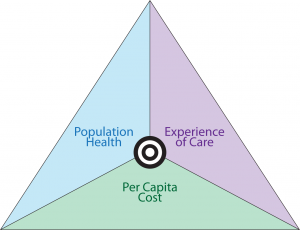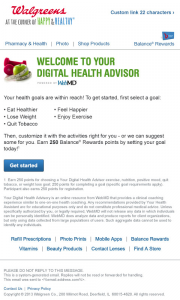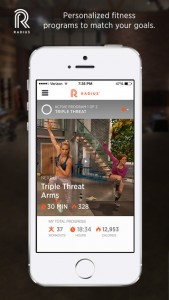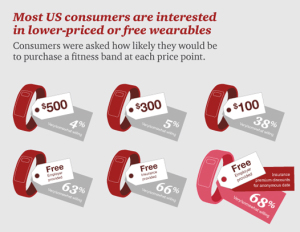 2015 is already becoming a year where bedfellows of different stripes are joining together to build a health care ecosystem well beyond hospitals, doctors and health plans. Announcements launched last week at the 2015 Consumer Electronics Show in Las Vegas, and coming out this week at the J.P. Morgan Conference in San Francisco, the first two weeks of 2015 reveal that new entrants and legacy health stakeholders are crossing corporate and cultural chasms to (try and) solve challenges that prevent us from getting to that Holy Grail of The Triple Aim: improving health care outcomes, driving down per capita costs, and enchanting the patient journey of health care.
2015 is already becoming a year where bedfellows of different stripes are joining together to build a health care ecosystem well beyond hospitals, doctors and health plans. Announcements launched last week at the 2015 Consumer Electronics Show in Las Vegas, and coming out this week at the J.P. Morgan Conference in San Francisco, the first two weeks of 2015 reveal that new entrants and legacy health stakeholders are crossing corporate and cultural chasms to (try and) solve challenges that prevent us from getting to that Holy Grail of The Triple Aim: improving health care outcomes, driving down per capita costs, and enchanting the patient journey of health care.
Multi-tasking on many tracks via many nodes in the health ecosystem is Walgreens, which we can no longer call a “chain pharmacy.” Walgreens is expanding its global health footprint through its acquisition of Alliance Boots, a multinational pharmacy group (wholesale and retail) with strong market share in Europe. The merger deal was finalized on 31st December 2014 which bolstered Walgreens’ health presence as of the first day of this new year. A few days later, Walgreens announced it would collaborate with Qualcomm Life to enhance digital connectivity between members of the loyalty program Balance Rewards and users’ digital health tools through the 2net platform. Walgreens also expanded the partnership with WebMD for Your Digital Health Advisor, a virtual coaching program that enables users to set goals, receive real-time advice via pharmacy chat, and inspire peoples’ healthier decisions. In turn, Qualcomm is partnering with Novartis, the pharmaceutical company, to develop solutions “beyond the pill” as part of the pharma’s Trials of the Future initiative.
 Another growing player in the consumer’s health ecosystem is CVS Health, whose business won’t include revenues from tobacco sales, dropped in September 2014 when the company rebranded from its identity as a pharmacy chain (CVS/pharmacy) to a broader focus on health. At today’s JPM meet-up, company CEO Larry Merlo talked about the company’s multi-channel, multi-segment health business. In addition to retail pharmacy, health and beauty, the company covers retail health through the Minute Clinic with nearly 1,000 urgent care clinics, and plans to grow to 1,500 by 2017; medication adherence and post-acute care support to patients; the ExtraCare loyalty program and leveraging the data collected over the 16 years of the program; and Caremark, the pharmacy benefit business with a fast-growing specialty drug component. CVS Health is looking to expand population health support to consumers and will be partnering with providers to do so. More on Merlo’s remarks can be found in this .
Another growing player in the consumer’s health ecosystem is CVS Health, whose business won’t include revenues from tobacco sales, dropped in September 2014 when the company rebranded from its identity as a pharmacy chain (CVS/pharmacy) to a broader focus on health. At today’s JPM meet-up, company CEO Larry Merlo talked about the company’s multi-channel, multi-segment health business. In addition to retail pharmacy, health and beauty, the company covers retail health through the Minute Clinic with nearly 1,000 urgent care clinics, and plans to grow to 1,500 by 2017; medication adherence and post-acute care support to patients; the ExtraCare loyalty program and leveraging the data collected over the 16 years of the program; and Caremark, the pharmacy benefit business with a fast-growing specialty drug component. CVS Health is looking to expand population health support to consumers and will be partnering with providers to do so. More on Merlo’s remarks can be found in this .
Digital health companies are extending their business further into the health ecosystem by partnering with organizations where people live, work, play and learn. Adidas announced a partnership with Interactive Health Technologies to bring the sports company’s Micoach tracking and training expertise to students in schools. IHT works with middle and high school physical education programs to promote healthy living and activity. Some 240,000 students were involved in IHT programs in 2014, and will ramp to over 1 million students a day in 2016. By working with young people in this program, Adidas can inspire families in their own micro-health ecosystems to nurture health at home.
On a parallel track, Adidas is re-defining what a “superstar” is, using celebrities like David Beckham and Pharrell Williams, et al., who talk about courage and “superstardom” in homage to the 45-year old Adidas Originals Superstar shoe. Here’s a video to explain…
Going beyond its well-known athletic textile branding, Under Armour, acquired the digital health app company MapMyFitness in 2013. The MapMyFitness community boasts over 30 million users. At CES 2015, Under Armour launched its alliance with HTC, the smartphone company, to co-create digital health tools that will work with the UA Record, a health data apps platform, part of the Under Armour Connected Fitness umbrella. Gisele Bundchen has been associated with the company since last year, seen in this video promoting the UA Record.
 Media is another health ecosystem player that underpins information, channeling and personalization. Here’s a venture that brings together health with entertainment, a pairing that can bolster the New Year’s fitness resolver to stick with a program over time. Late in 2014, NBCUniversal launched the Radius app and network, providing health workouts and coaching via TV, computer and mobile platforms. Radius is working with a long list of digital health devices and wearable technologies. I spent time with Keoni Hudoba, one of Radius’s “rock star trainers,” during CES, and he shared his own dramatic weight loss story with me. This program could be welcomed as authentic, inspiring and motivating for real people who are looking for an at-home coaching experience rather than paying for the gym — and eventually avoiding it.
Media is another health ecosystem player that underpins information, channeling and personalization. Here’s a venture that brings together health with entertainment, a pairing that can bolster the New Year’s fitness resolver to stick with a program over time. Late in 2014, NBCUniversal launched the Radius app and network, providing health workouts and coaching via TV, computer and mobile platforms. Radius is working with a long list of digital health devices and wearable technologies. I spent time with Keoni Hudoba, one of Radius’s “rock star trainers,” during CES, and he shared his own dramatic weight loss story with me. This program could be welcomed as authentic, inspiring and motivating for real people who are looking for an at-home coaching experience rather than paying for the gym — and eventually avoiding it.
Intel, having purchased Basis Science last year, is evolving as a key node in the health ecosystem. At CES 2015, Intel Like many wearables technology suppliers, Intel has allied with fashion companies – for Intel, they’re Fossil (the watch design company) and Luxottica (the luxe Italian eyewear firm – THINK Ray-Ban, Persol, and Oakley). The company works with 50 Cent on fitness headphones, and is developing MICA (My Intelligent Communications Accessory) with Opening Ceremony. This video speaks to Intel’s work on the BIOSPORT in-ear headphones for fitness-minded music fans.
Health Populi’s Hot Points: People don’t really want to engage much with health care, but they do engage with health and express that engagement through spending hard dollars on healthful things. For decades, health consumers have allocated out-of-pocket, post-tax earnings on vitamins, minerals and supplements, weight scales, gym memberships, food with perceived nutritional benefits, psychotherapy, yoga, and other tools that haven’t traditionally been covered by health insurance.
Now that U.S. health citizens face greater out-of-pocket costs for health care, in the forms of high deductibles and greater cost-sharing for services and products like expensive specialty drugs, people are project-managing health care in new ways beyond their legacy healthcare system: outside of doctor’s offices, clinical laboratories and medicine prescriptions. Health citizens are also digital citizens, with smartphones their prevalent communications platform technology adopted by most people in the U.S.
 PwC’s study into wearable technology for health found that consumers would prefer their adoption of such devices be subsidized by a third party: say, a health insurer or employer that sponsors health insurance. We expect enterprise involvement in nudging, inspiring and, indeed, paying for (at least part) of the cost of health-focused wearable technology, shown in the last graphic. This demand generation and support is also part of the evolving health ecosystem – bringing the supply side of digital health tech with the demand side.
PwC’s study into wearable technology for health found that consumers would prefer their adoption of such devices be subsidized by a third party: say, a health insurer or employer that sponsors health insurance. We expect enterprise involvement in nudging, inspiring and, indeed, paying for (at least part) of the cost of health-focused wearable technology, shown in the last graphic. This demand generation and support is also part of the evolving health ecosystem – bringing the supply side of digital health tech with the demand side.
Furthermore, the health/wearables nexus isn’t a supply-induced-demand market. That is, just by building these devices, people won’t “come” to them willingly: about 1 in 10 U.S. adults has adopted a fitness wearable, and there’s no market signal that points to go-go adoption for the next couple of years.
Wearable Devices as Facilitators, Not Drivers, of Health Behavior Change is the title of an article published in this week’s JAMA (Journal of the American Medical Association, journal issue dated January 8, 2014). In this brief, Drs. Patel, Asch and Volpp, all of the University of Pennsylvania, note that big players like Apple, Google and Samsung are entering the “expanding market of population health,” knowing that there’s a gap between tracking health information and changing health behavior. The authors, all physicians, two with an MBA and one with a PhD, conclude that for the devices to drive real and sustainable behavior change, they need to be adopted in the context of well designed engagement strategies – “combinations of individual encouragement, social competition and collaboration, and effective feedback loops that connect with human behavior,” in their words.
Thus, it will take a village to align incentives and get stakeholders (including consumers themselves) together to bolster The Triple Aim. The first couple of weeks of 2015 demonstrate that the villagers are coming together to build health ecosystems that go beyond simply generating data.




 Interviewed live on BNN Bloomberg (Canada) on the market for GLP-1 drugs for weight loss and their impact on both the health care system and consumer goods and services -- notably, food, nutrition, retail health, gyms, and other sectors.
Interviewed live on BNN Bloomberg (Canada) on the market for GLP-1 drugs for weight loss and their impact on both the health care system and consumer goods and services -- notably, food, nutrition, retail health, gyms, and other sectors. Thank you, Feedspot, for
Thank you, Feedspot, for  As you may know, I have been splitting work- and living-time between the U.S. and the E.U., most recently living in and working from Brussels. In the month of September 2024, I'll be splitting time between London and other parts of the U.K., and Italy where I'll be working with clients on consumer health, self-care and home care focused on food-as-medicine, digital health, business and scenario planning for the future...
As you may know, I have been splitting work- and living-time between the U.S. and the E.U., most recently living in and working from Brussels. In the month of September 2024, I'll be splitting time between London and other parts of the U.K., and Italy where I'll be working with clients on consumer health, self-care and home care focused on food-as-medicine, digital health, business and scenario planning for the future...